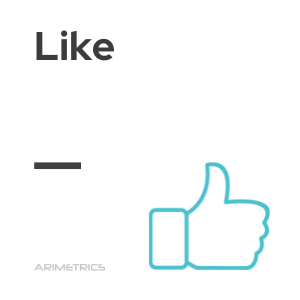 Definition:
Definition:
A “like” is a feature built into social networks and other online platforms that allows users to express their approval or interest in specific content. By clicking the “like” button, users can provide positive feedback quickly and easily, connecting with topics or posts that appeal to them. The “like” button was popularized by Facebook, which introduced it with great success in 2009.
This feature revolutionized online interaction due to its simplicity, allowing users to express their reaction to a post with just one click. The counterpart of the “like” is the “dislike”, which implies negative feedback. However, not all social networks include this option; for example, platforms such as X and Facebook lack a “dislike” button, while YouTube is one of the networks where it is present.
Characteristics of the likes
Here are some of the key characteristics that make “likes” so influential on digital platforms:
- Simplicity of use: “Likes” allow users to express approval with a single click, facilitating interaction.
- Positive feedback: They indicate that a content is interesting or valuable, providing positive feedback.
- Popularity indicator: They reflect social acceptance and can increase the visibility of a publication.
- Impact on the algorithm: They influence the positioning of the content on many platforms, affecting its reach.
- Social interaction: Encourage conversations and connections between users.
- Easy to measure: They serve as a quantifiable metric for evaluating content performance.
- Non-engaging: They offer a less engaging form of interaction than commenting or sharing.
- Versatility: They are used in a variety of contexts, from social networks to news sites.
- Influence on user behavior: They can attract more attention and generate a snowball effect.
Social Networks that use the like
Among the most prominent social networks that use “like” are:
- Facebook: A pioneer in popularizing the “like” button, Facebook has integrated this feature throughout its platform, allowing users to easily interact with posts, comments and photos.
- YouTube: On YouTube, “likes” (and “dislikes”) are fundamental to indicate the quality and relevance of videos, influencing their visibility and algorithm recommendations.
- LinkedIn: In the professional arena, LinkedIn uses “like” to facilitate interaction with articles, status updates and professional achievements, helping users to show support and recognition.
- X (formerly Twitter): Although X does not have a “dislike” button, the “like” is a key tool for expressing approval and saving tweets for future reference.
- Instagram: Here, the “like” is essential to measure the popularity of photos and videos, and plays an important role in the algorithm that determines what content is shown to users.
- Vine: Although no longer in operation, Vine used “likes” to measure the popularity of its short video clips, influencing their dissemination.
- Flickr: This photography platform allows users to “favor” images, functioning similarly to a “like” to express appreciation for the work of other photographers.
- Reddit: With its upvotes and downvotes system, Reddit allows users to give positive or negative feedback, affecting the visibility of posts.
Like in digital marketing
In digital marketing, the “like” is considered a valuable metric for assessing the popularity and impact of content generated on social networks. Companies use this metric to analyze the acceptance of their posts and adjust their strategies accordingly. Content creators strive to produce original and useful posts in order to get more “likes” and stand out from the competition. Thus, “likes” not only reflect audience preference, but also influence the positioning and success of digital campaigns.
